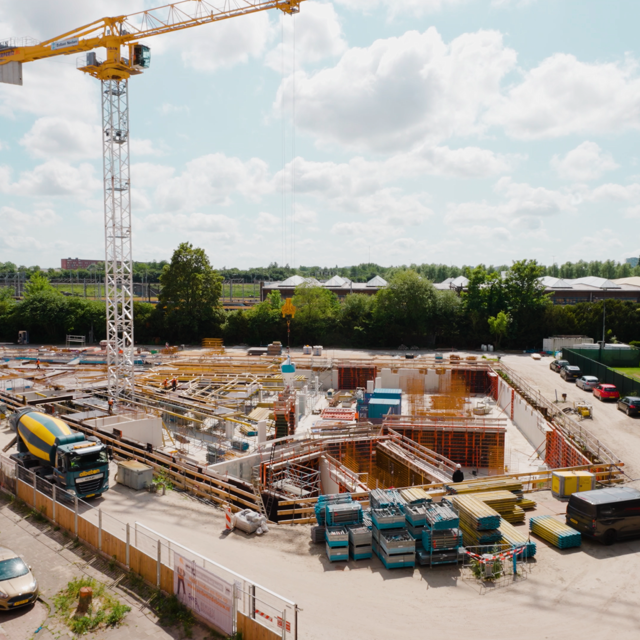'Circularity challenges us to think even harder about our projects'
As challengers, our colleagues challenge the market. Rosa Bos is one of them. It hunts for the large and small opportunities to apply circular ideas in construction.
As a master's student Rosa graduated in the design of circular offices. At Ballast Nedam she started as a trainee in the calculation, planning and logistics departments. She currently works at a construction site daily, in her role as a trainee work planner at Galaxy Tower in Utrecht. She makes conscious choices. For example, she asks suppliers about their options for supplying plastic-free materials and for providing smart dimensions so that we throw away as few materials as possible on the construction site.
You are still at the beginning of your career, but you are already fully committed to this topic. Where does that passion come from?
“I am aware that we are the generation that needs to do better. Construction appeals to me for two reasons. The maker aspect is one of them. Building something beautiful together, that's great. In addition, construction has a huge impact on the environment. There are still many opportunities to make this sector more sustainable and I find that interesting. With circular construction we are challenged to think even better about how we realise a project and what can be done with it in the future. Circular construction is actually nothing more or less than solid construction. You build with materials that are available and/or renewable and you design a building so that it can be reused in another function or location. During this process you emit fewer emissions and waste is minimized.”
I am aware that we are the generation that needs to do better
“It starts with attracting different parties. Circularity does not only work if the contractor wants something with it or if the client has it on his wish list. We also need to involve the architect, constructor, consultant, supplier, manager, demolition contractor and financiers in circularity. As Ballast Nedam, we have a contractor perspective in which we can use our knowledge of materials and construction methods. I therefore think that contractors should be involved earlier during the development of a circular building. For example, simply prescribing secondary materials is not convenient. It is especially important to have more conversations between contractors and clients about quality requirements and guarantees for circular materials. In addition, we can purchase more efficiently and create less cutting waste by working with standard sizes in the design. The contractor can also provide advice on the feasibility of a design and the practical applicability of circular design choices. This sounds logical, but there is really still a lot to be gained from this.”
You work as a Trainee at Galaxy Tower on the Jaarbeursplein in Utrecht, across from the circular pavilion The Green House, which we built in 2017. Working with a circular view. How is that?
“It inspires me to see a good practical example up close. Above all, I am absorbing everything like a sponge. What do my colleagues encounter? What is practical? And what not? When you get out of college, you have really big ideas about how it should be. But how does it work in practice?”
“The government wants to build 100% circularly in 2050. That's what I aspire as well, but we have to keep it practical. The Green House does inspire me. Ballast Nedam built the pavilion partly with materials that we had left over from the former Knoop barracks next door. It is completely dismountable. Time will tell whether it will actually be dismantled and reused. But it is possible and it is largely made of materials that would otherwise have ended up on the scrapyard. That's a different way of constructing. I see the power of that: looking at what is already there and creating value with it. Thinking the other way around, basically.”
“As part of the Ballast Nedam teams, I am committed to the circular platform CB'23: a platform with various parties from the construction sector. Together we are trying to make uniform construction agreements about circular construction in 2023. This initiative came from the government, Rijkswaterstaat and market parties.”
“In addition, I want to challenge my colleagues to take action themselves to reduce our environmental impact. We can achieve this by, for example, buying smartly and pointing out potential savings in material and energy to our clients. We can also use less paper and opt for an electric lease car. I encourage this knowledge sharing internally through webinars and conversations, both on the custruction sites and at the office.”
I want to challenge my colleagues to take action themselves to reduce our environmental impact.
"Absolutely. I do indeed see a lot of empty offices. If we had thought about creating more purposes than just an office function beforehand, it would have made a huge difference. During construction, a changing, uncertain future must already be taken into account. If you give an office multiple entrances, the building will be easier to split up later. Then the chance of vacancy is less. Responding to a changing future is something we can do better from now on.”
“The idea is actually not that difficult. In its purest form, it is: only build what you really need. And if you are going to build, you have to be able to reuse it. That is my dream: to create a housing and building stock that can be used for a long time and has low emissions. That would be healthier for our planet and people. And I hope we achieve that with "value" in mind, rather than costs. I believe that circularity can change the construction world. That is desperately needed, but we need everyone to team up together.”





